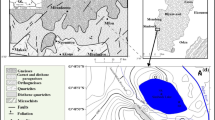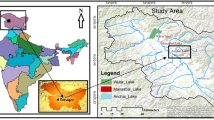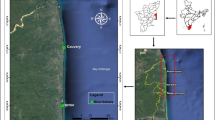Abstract
Based on the geochemical elements Rb and Sr in sediments with three different grain size fractions from profile H3 on the northern lacustrine bottomland 13 m above the Huangqihai Lake surface in 1986, the paper investigates the record of palaeolake stand state, sedimentary environmental evolution, and winter monsoon change. First, these samples are separated into three different grain size fractions, i.e., total sediments, 77-20 μm and <20 μm. Second, the chemical elements—Rb and Sr—of the grain size separation were tested and analyzed systematically in this paper. Then the elements compositions of these samples are measured using VP-320 mode fluorescence spectrum instrument, respectively. The magnetic susceptibility of these samples is measured using Kappabridge KLY-3 mode instrument made in Czech AGICO Company. The results showed the elements and the ratios varied regularly with the grain size. But the ratio of Rb/Sr in the sediments <20 μm correlates positively with the magnetic susceptibility of these samples. Therefore, the ratio of Rb/Sr in the fraction <20 μm from the lake sediments reflected the strengthening of the weathering in the deposition sites. It is a good indicator of the summer monsoon-induced weathering and pedogenesis fluctuations and can be used to reconstruct the conditions of the paleoclimate and paleoenvironment.
Similar content being viewed by others
References
An Chengbang, 2004. Holocene environment change in the western part of the Chinese Loess Plateau and its effect on prehistoric cultural development. Lanzhou University, 63. (in Chinese)
An Zhisheng, Wu Xihao, Wang Pinxian et al., 1991. China palaeomonsoon in the last 130 ka: I. Record of palaeomonsoon. Science in China (Series B), 3434(10): 1076–1081. (in Chinese)
Blunier T, Chappellaz J, Schwander J et al., 1995. Variations in atmospheric methane concentration during the Holocene epoch. Nature, 374: 47–50.
Bond G, Showers W, Cheseby M et al., 1997. A pervasive millennial-scale cycle in north Atlantic Holocene and glacial climates. Science, 278: 1257–1266.
Chen Fahu, Zhu Yan, Li Jijun et al., 2001. Fast changes of summer monsoon millenary scale Holocene, recorded from lacustrine sedimentary records in Minqin basin. Chinese Science Bulletin, 46(17): 1414–1418. (in Chinese)
Chen Jun, An Zhisheng, Wang Yongjin et al., 1998. Distribution of Rb and Sr in the Luochuan loess-paleosol sequence of China during the last 800 ka: Implications for palaeomonsoon variations. Science in China (Series D), 28(6): 498–504. (in Chinese)
Dasch E J, 1969. Strontium isotopes in weathering profiles, deep-sea sediments, and sedimentary rocks. Geochim Cosmochim Acta, 33: 1521–1552.
Grootes P M, Stuiver M, White J W C et al., 1993. Comparison of oxygen isotope records from the GISP2 and GRIP Greenland ice cores. Nature, 366: 552–554.
Ingram B L, Sloan D, 1992. Strontium isotopic composition of estuarine sediments as paleosalinity-paleoclimate indicator. Science, 255: 68–72.
Jin Guiyun, Liu Dongsheng, 2001. Ancient culture change and cooling climatic events mid-Holocene in north of China. Chinese Science Bulletin, 46(20): 1725–1730. (in Chinese)
Jin Zhangdong, Wang Sumin, Shen Ji et al., 2001. Weak chemical weathering during the Little Ice Age recorded by lake sediments. Science in China (Series D), 31(3): 221–225. (in Chinese)
Jin Zhangdong, Wang Sumin, Shen Ji et al., 2004. Watershed chemical weathering and its response to climate events in Daihai area during Holocene. Geochimica, 33(1): 29–36. (in Chinese)
Li Huazhang, Liu Qingsi, Wang Jiaxing, 1992. Study of evolution of Huangqihai and Daihai lakes in Holocene in Inner Mongolia Plateau. Journal of Lake Sciences, 4(1): 31–39. (in Chinese)
Liu Tungsheng, 1966. Loess Composition and Texture. Beijing: Science Press, 46–56. (in Chinese)
Liu Xingqi, Shen Ji, Wang Sumin et al., 2002. Palaeoclimate and palaeoenvironment evolution of Qinghai Lake by pollen data since 16 kaBP. Chinese Science Bulletin, 47(17): 1351–1355. (in Chinese)
Ren Zhenqiu, 1984. a period of frequent natural calamities around 2000 B.C. Exploration of Nature, (4): 145–149. (in Chinese)
Shen Hongyuan, Jia Yulian, Zhang Hongmei, 2006. Environmental change inferred from granular size character of lacustrine sediment in Inner Mongolia Huangqihai, during 8.0–2.2 ka BP. Arid Land Geography, 29(4): 457–462. (in Chinese)
Shi Yafeng, Zhang Piyuan, 1996. The climate and sea surface changes in China and their influences and tendency (Part 1): Climatic Change of China History. Jinan: Shandong Science Press, 5–31. (in Chinese)
Siim V, Heikki S, Antti E K O, 2004. Cold event at 8200 yr B.P. recorded in annually laminated lake sediments in eastern Europe, Geology, 32(8): 681–684.
Song Changqing, Lu Houyuan, Sun Xiangjun, 1997. Construction of pollen-climate factor transfer and its application in North China. Chinese Science Bulletin, 42(20): 2182–2185. (in Chinese)
Staubwasser M, Sirocko F, Grootes P M et al., 2003. Climate change at the 4.2 kaBP termination of the Indus valley civilization and Holocene south Asian monsoon variability. Geophysical Research Letter, 30(8): 1425–1431.
Stuiver M, Yang I C, Denton G H et al., 1975. Climate versus change in 13C content of the organic component of lake sediments during the late Quaternary. Quaternary Research, 5: 251–262.
Wang Sumin, Wang Fubao, 1992. Climatic changes of Holocene recorded from lake sedimentary record. In: Shi Yafeng (ed.). Climate and Environment in China during the Holocence Megathermal. Beijing: China Ocean Press, 146–152. (in Chinese)
Weiss H, Courty M A, Wetterstrom W et al., 1993. The genesis and collapse of third millennium North Mesopotamian civilization. Science, 261: 995–1004.
Wen Qizhong, 1989. Geochemistry of Chinese Loess. Beijing: Science Press, 36–63. (in Chinese)
Xu Jinghua, 1998. Sun, climate, famine and folk nation transfer. Science in China (Series D), 28(4): 366–384. (in Chinese)
Xu Qinghai, Xian Jule, Toshio N et al., 2003 Quantitative reconstructed climatic changes of Daihai Basin by pollen data. Marine Geology & Quaternary Geology, 23(4): 99–108. (in Chinese)
Yang Defu, Peng Shuzhen, 2001. A preliminary study on the main chemical elements distributions of the different particles in eolian deposition. Journal of Shandong Agricultural University (Natural Science), 32(2): 152–156. (in Chinese)
Author information
Authors and Affiliations
Corresponding author
Additional information
Foundation: National Natural Science Foundation of China, No.40401006
Author: Chen Lei (1971–), Associate Professor and Master, specialized in environmental evolvement.
Rights and permissions
About this article
Cite this article
Chen, L., Shen, H., Jia, Y. et al. Environmental change inferred from Rb and Sr of lacustrine sediments in Huangqihai Lake, Inner Mongolia. J. Geogr. Sci. 18, 373–384 (2008). https://doi.org/10.1007/s11442-008-0373-1
Received:
Accepted:
Published:
Issue Date:
DOI: https://doi.org/10.1007/s11442-008-0373-1




